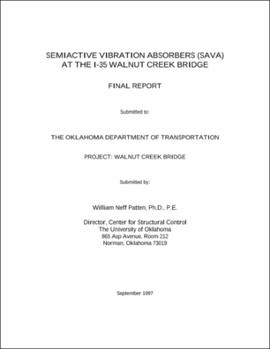| dc.description.abstract | The project was undertaken to develop and field test an automatically controlled bridge mounted vibration absorber. The system, referred to as a semiactive vibration absorber (SAVA) consists of a hydraulic cylinder coupled to structural steel elements that bolt on to an existing bridge. The hydraulic cylinder (HC) is equipped with a computer-controlled valve and sensors. The sensors are used to detect the motion of the bridge girders that results from the passage of heavy multiaxle trucks. The research resulted in the establishment of a smart software code that opens and closes the valve on the HC at appropriate times during the vibration. The modulation of the valve affords an optimized combination of both stiffiless and damping, which results in a significant reduction of vibration amplitude and maximum stress in the girders. Field testing of the SAVA system was conducted on the Walnut Creek Bridge at the 92.7 mile marker on I-35 between Dallas, TX and Oklahoma City, OK. The bridge has a two-lane, 38' wide composite deck, supported by five 134 lb/ft girders mounted at 8' 611 centers. The continuous 400' long girders were supported at 100 foot intervals by three piers and abutments at either end of the bridge. The SAVA system was installed in the Summer 1996 on one span of the bridge, and field-tested for over 12 months. The results indicate a nominal reduction of truck-induced stress and deflection of over 55%. The tests were conducted using four multi-axle trucks with weights ranging from 27 klbs to 120 klbs, traveling at the posted speed limit. NCHRP 299 (1989) was used to determine the remaining safe life of the bridge. The most conservative estimate indicates that the span, in which the SAVA system is mounted, gained an additional 60 years of safe life and over 150 years of mean life. The estimated safe life of the bridge prior to the installation of the SAVA system was -7 yean. The system operates on a 12-volt battery that is rated to last over two years. The instrumentation required include two sensors (per actuator). The entire SAVA system was mounted from below, without having to impede traffic. The estimated cost of the system is approximately 7% to 10% of the cost to replace the bridge. The performance of the system and the integrity of the electronics is routinely checked via a remote monitoring system. The work proved conclusively that the semiactive vibration absorber system is robust to climate conditions and is inherently safe. A patent has been awarded(# 5545372) for this technology. | |
